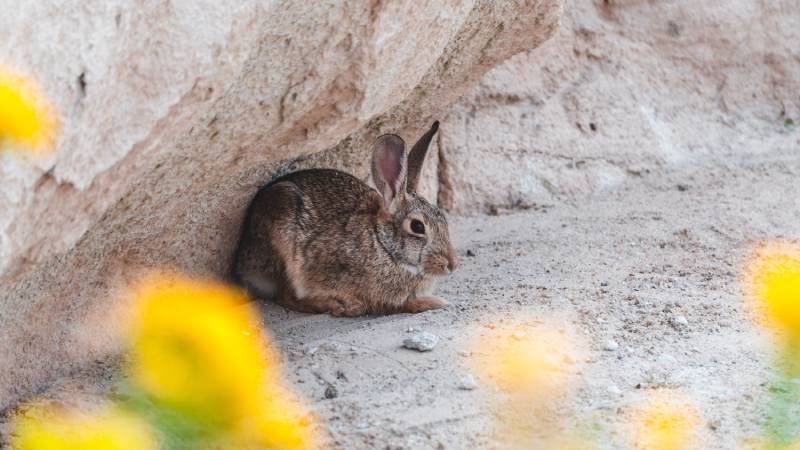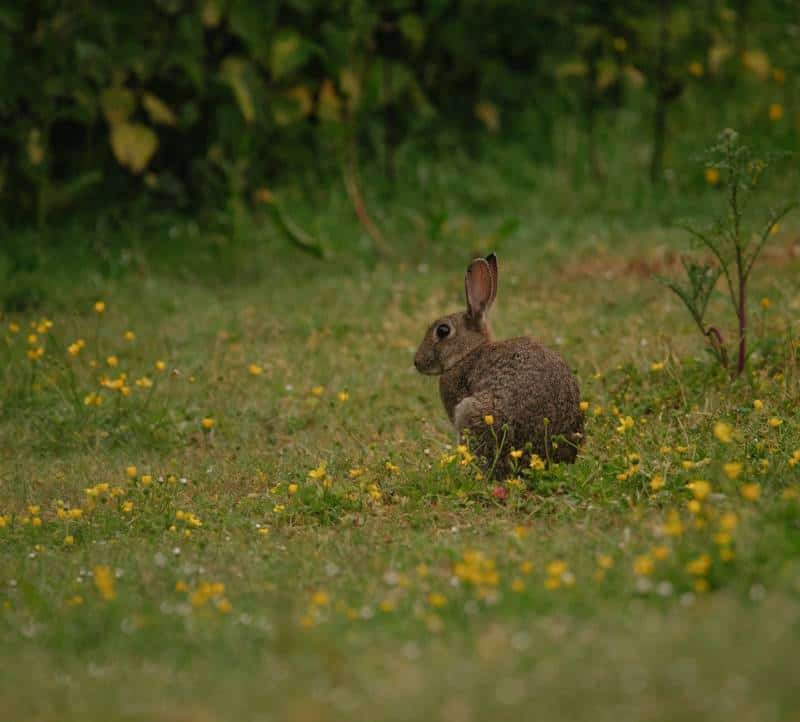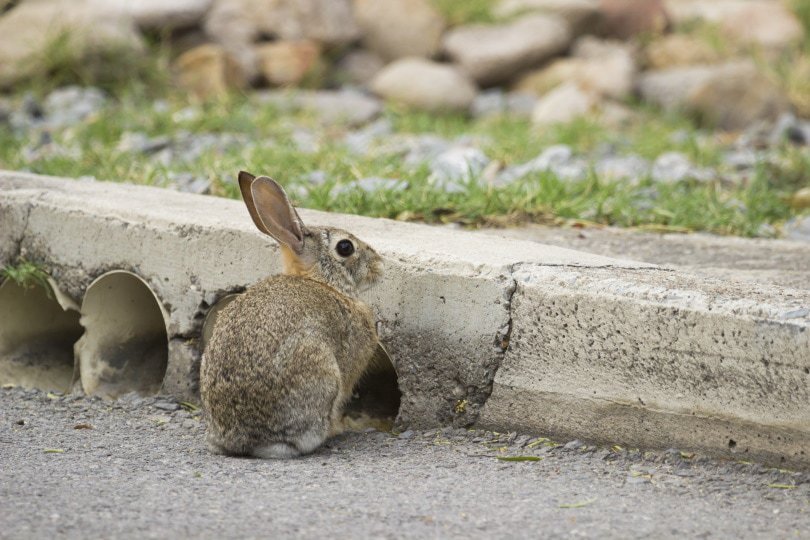The Mexican Cottontail rabbit is a native animal in Mexico. You can find them hopping around a backyard or sprinting around the forest. These skittish creatures might be so adorable that you wish to have one of your own. Unfortunately, the Mexican Cottontail is a prey animal that is very frightened by outside contact.
These animals are protected and preserved, cared for by wildlife professionals only. In this article, we will discuss all of the interesting facts about the Mexican Cottontail’s life cycles and explain what to do if you find one.
| Size: | Small |
| Weight: | 5.5 pounds |
| Lifespan: | 15 months |
| Similar Breeds: | American Cottontail |
| Suitable for: | The wild |
| Temperament: | Shy, timid |
The Mexican Cottontail is one of the largest rabbits in Mexico. This particular species was discovered by English naturalist George Robert Waterhouse in 1848. These rabbits inhabit a specific portion of Mexico and have interesting life cycles. These rabbits are not pet material, and we’ll tell you why.

Mexican Cottontail Rabbit Characteristics

Temperament & Intelligence of the Mexican Cottontail Rabbit
Like many rabbits, these prey animals are always on high alert. Many predators track and kill these small animals, so they have to be on the lookout at all times. They are so geared toward self-preservation that they sleep with their eyes open – literally. You might notice that this rabbit never seems fully relaxed.
Their bulbous eyes help them see a large field around them to prevent them from falling victim to a predator. They move very swiftly, achieving speeds up to 30 mph when frightened.
During the zigzag motion, known to throw off prey, they typically travel at speeds up to 18 mph. These incredibly efficient rabbits display a natural burrowing behavior. They tend to hide underground, digging burrows that protect them and their young.

Do These Rabbits Make Good Pets?
Mexican Cottontail rabbits are absolutely, in no way, shape, or form, a pet. These wild rabbits are found in nature and should not be domesticated for any other reason than necessary rehabilitation.
If you have found a litter of Mexican Cottontail rabbits or believe one to be injured, it’s best to contact a wildlife rehabilitation center that can guide you on what to do next. The rescue might suggest bringing in the rabbit for evaluation or could come pick up the rabbit to transport it.
Baby rabbits leave their burrows very early and will still be small when they enter the world. Please never try to capture a young rabbit, as they are likely fine alone. The reality is, we don’t have the education or proper housing to give wild rabbits the life they need.
Mexican Cottontails will never be a cuddly bunny that you can enjoy. They will always be skittish and very afraid of you. If you’re interested in having a rabbit as a pet, get a domesticated rabbit from a licensed breeder or pet shop instead.

Does This Rabbit Get Along with Other Animals?
Mexican cottontails are not compatible with any other species. These prey animals are exceptionally terrified of any other creature, as they believe they will fall victim to being lunch.
That means that if you catch a Mexican Cottontail or try to domesticate it, it will always be on high alert and very frightened when around any existing pets. Getting your pet to be a rabbit’s friend can stress them out and shorten their lifespan.
If you ever had a Mexican Cottontail around a family dog or cat, it would naturally trigger their startle response, and it could result in sudden death. So, if you notice a Cottontail hopping around your yard, don’t release your dogs out to investigate.

Things to Know About Mexican Cottontail Rabbit:
Food & Diet
Mexican Cottontail rabbits are strict herbivores. They require a series of grasses and other plant life to maintain themselves. In the summer months, you can watch them enjoy common favorites like:
- Indian ricegrass
- Sagebrush
- Bottlebrush squirreltail
- Cheatgrass brome
- Bluegrass
- Wheatgrass
- Saltbush
These rabbits are considered crepuscular, meaning they are most active in low light hours. Generally, their feeding happens at dawn and dusk. They feed typically at both times but do not munch much during the day.
Habitat
Mexican Cottontail rabbits can thrive in several different climates and environments. They prefer areas where foliage is abundant and hiding places are easily accessible. You can find them in meadows, forests, grasslands, and even moderately populated areas.
The Mexican Cottontail will seek refuge in thickets, tall grasses, and brush for the most part. However, they also dig burrows and take refuge underground. It is not uncommon for these rabbits to sleep with their eyes open, especially if they feel an absence of security.

Population Threats
Unfortunately, the Mexican Cottontail has quite a few predators in the wild. These rabbits make abundant food sources for native species such as:
- Red foxes
- Coyotes
- Long-tailed weasels
- Feral dogs
- Great horned owls
- Red-tailed hawks
Naturally, humans also greatly contribute to population loss amongst Cottontail rabbits. With the increase in industrialization, their natural habitats will continue to diminish. Typically, these rabbits live just a few short years in the wild.
Mating Habits
Many factors influence breeding, such as temperature and environmental factors. Mexican Cottontails have continuous breeding cycles occurring throughout the year. However, litters are much more common when the weather is warm in spring and summer. These rabbits choose new mates each time, and the fathers do not partake in rearing the offspring.
Before mothers ever give birth, they will dig a nursery burrow consisting of short and shallow tunnels with various chambers. The mothers will construct these nests of multiple materials, such as hardy plants, pine needles, and dry grasses.
These grasses also provide a food source for the mother during her nursing cycle. Initially, the mother nurses the babies toward the entrance of the burrow. Once the babies reach 12 weeks old, it’s time to go out independently.
Male vs Female
Male and female Mexican Cottontails can be sexed through visual observation. Often, it isn’t easy to tell, as they both look identical to the naked eye. If you are a licensed professional handling these animals, you can easily sex the rabbits by checking the genital opening.
Both male and females remain sexually active throughout the year.

3 Little-Known Facts About Mexican Cottontail Rabbit
1. Mexican Cottontails are the largest Mexican rabbit.
The Mexican Cottontail is the largest in all of Mexico, weighing up to 5 pounds.
2. Mexican Cottontails have different nesting patterns than some other Cottontails.
Interestingly, the Mexican Cottontail does not behave like many other Cottontails. They burrow themselves while other rabbits, such as Eastern Cottontails, use pre-existing burrows from other animals to seek refuge.
3. Mexican Cottontails are incredibly fast.
Mexican Cottontails are quite zippy—and they are lucky! They can quickly escape predators using a confusing zigzag pattern or even outrun them in forward motion, traveling up to 30 miles per hour!

Final Thoughts
Remember, while it’s tempting to domesticate a wild rabbit, the Mexican Cottontail belongs in nature. These rabbits are not meant to be pets in any way and will never make a suitable pet.
If you find a wild rabbit that has been injured, make sure to contact a local wildlife rescue for further guidance. They must get the care that they need so they can resume their life in the great outdoors.
Related Breeds:
- Mountain Cottontail
- Appalachian Cottontail
- Desert Cottontail Rabbit: Facts, Origin & History (With Pictures)
Featured Image Credit: Heliopixel, Shutterstock
